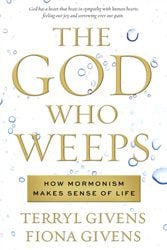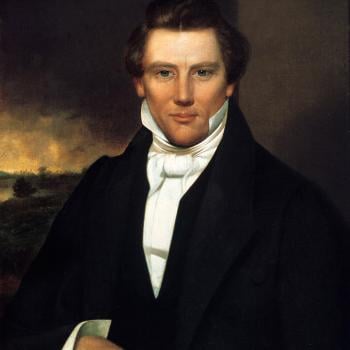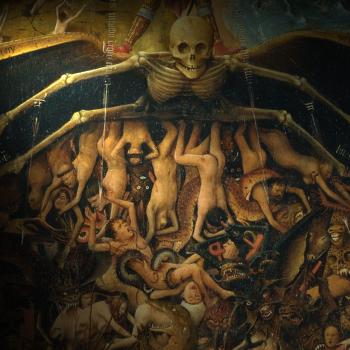At first glance, Mormonism is not an especially creedal religion. Brigham Young, the second president of the Church of Jesus Christ of Latter-day Saints, demanded practical, ongoing self-sacrificial service to the church, not an assent to a particular group of doctrines. After his 1848 return to the Salt Lake Valley, Young informed its early settlers that they would have to forego sermons on “the glories of the eternal worlds.” Instead, he would tell them “what is wanting today.” What one did in the here-and-now was more important than what one believed about the hereafter (or, in the LDS case, the pre-existent).
Even today, theology sometimes seems extraneous to much of Latter-day Saint life, so focused on the family, church service, and reverence for modern-day prophets. Outsiders are often confused about what exactly Latter-day Saints believe, and the “Articles of Faith” included in the Pearl of Great Price (one of three additional Mormon works of scripture alongside the Book of Mormon and Doctrine & Covenants) only partly illuminate distinctively Mormon beliefs.
 Enter The God Who Weeps: How Mormons Make Sense of Life, co-authored by Terryl and Fiona Givens. Most simply, the authors succinctly articulate “five propositions pertaining to who presides over this universe, where we came from, why we are here, and what might await us in the ‘undiscovered country.'” The last four propositions will be familiar, both to Latter-day Saints and outsiders acquainted with the church: a spiritual preexistence with God in advance of mortality; mortality as an “ascent” into “the school house of the world,” an existence filled with joy, sorry, and potential; the salvation of nearly everyone; the persistence in heaven “of those relationships that matter most to us now.” (I will circle back to the first proposition below).
Enter The God Who Weeps: How Mormons Make Sense of Life, co-authored by Terryl and Fiona Givens. Most simply, the authors succinctly articulate “five propositions pertaining to who presides over this universe, where we came from, why we are here, and what might await us in the ‘undiscovered country.'” The last four propositions will be familiar, both to Latter-day Saints and outsiders acquainted with the church: a spiritual preexistence with God in advance of mortality; mortality as an “ascent” into “the school house of the world,” an existence filled with joy, sorry, and potential; the salvation of nearly everyone; the persistence in heaven “of those relationships that matter most to us now.” (I will circle back to the first proposition below).
Those four propositions have been central to the Mormon faith since its infancy. One finds at least some of them in the Book of Mormon itself: “Adam fell that might men be; and men are, that they might have joy.” A retelling and reinterpretation of the experiences of Adam and Eve, 2 Nephi 2 is one of the most poignant and beautiful passages in the Book of Mormon. Without the fall, without Adam and Eve’s transgression, “they would have had no children; wherefore they would have remained in a state of innocence, having no joy, for they knew no misery; doing no good, for they knew no sin.”
Protestants and Catholics reading either the Book of Mormon or the authors’ explication of it will almost certainly object to the hint of anything fortunate about the fall. They will likely have similar reactions to the idea of a premortal existence, the sealing of earthly relationships in order for them to persist into eternity, and perhaps to the Mormon concept of nearly universal salvation. Nevertheless, The God Who Weeps rather winsomely suggests that other Christians should respect Mormon beliefs by connecting them to a wealth of Christian, Jewish, and philosophical antecedents. For example, they find suggestions of the above reinterpretation of the “fall” in the medieval mystic Julian of Norwich’s vision of Adam. There is nothing combative in their presentation of Mormon doctrine. Instead, they stress its congruence with reason and truth wherever they are found. Outsiders to Mormonism looking for an introduction to contemporary Mormon beliefs would be well served to begin here, not because The God Who Weeps presents Mormon theology systematically or answers every objection to its arguments. They should begin here because charitable readers should engage religious traditions at their most winsome and accessible.
At the same time that the authors stress the reasonableness of Mormon beliefs, they also acknowledge the reasonableness of human doubt and skepticism (for Latter-day Saints and others). These passages reminded me of Tanya Luhrmann’s discussion of doubt (in her When God Talks Back) as a necessary component of contemporary spirituality. Terryl and Fiona Givens know that outsiders generally do not respect Mormon theology, but they also know that many Latter-day Saints themselves struggle with doubt within a church that often seems to make little room for skepticism. “In the case of us mortals,” they write, “we are confronted with a world in which there are appealing arguments for a Divinity that is a childish projection, for prophets as scheming or deluded imposters, and for scriptures as so much fabulous fiction. But there is also compelling evidence that a glorious Divinity presides over the cosmos, that His angels are strangers we have entertained unaware, and that His word and will are made manifest through a scriptural canon that is never definitively closed.” Even with a closed canon, Protestants and Catholics can well understand the evidence for both belief and doubt. Indeed, the “option to believe” appears to us, especially to us in today’s United States, “perched precariously between sets of demands held in dynamic tension.” Thus, all human beings face a choice, a free choice about whether or not to believe. That concept of free agency, along with the propositions listed above, is another core LDS belief (early Mormonism was part of a more general early nineteenth-century reaction against Calvinism).
Finally, to the book’s title and first proposition: “God is a personal entity, having a heart that beats in sympathy with human hearts, feeling our joy and sorrowing over our pain.” Thinking of its context within Mormonism, this first proposition struck me as the most innovative, indeed unusual, aspect of the book. The authors might have begun with spiritual preexistence (their second proposition), but instead they frame their book around a God who weeps over creation, especially the sorrow of those beings who have chosen the admixture of joy and misery found in mortality. Strangely, this proposition reminded me both of the sacred romance that evangelicals have with Jesus and the process theologians’ God who is changed by the world. “God is not radically Other,” conclude the authors, “and neither is His heaven.”
Unlike in 1850, the LDS Church no longer needs its members to concentrate wholly on the practical tasks set before them by their leaders. Instead, “what is wanting today” — for Mormons and for others — are good reasons to believe in the face of doubt, struggle, and sorrow. For many Latter-day Saints, The God Who Weeps will help provide those reasons. For Mormons and others, moreover, Terryl and Fiona Givens provide a glimpse of the logic, beauty, and long heritage of those doctrines at the heart of their church.
This post is part of the Patheos Book Club conversation about The God Who Weeps: How Mormonism Makes Sense of Life, by Terryl and Fiona Givens.












